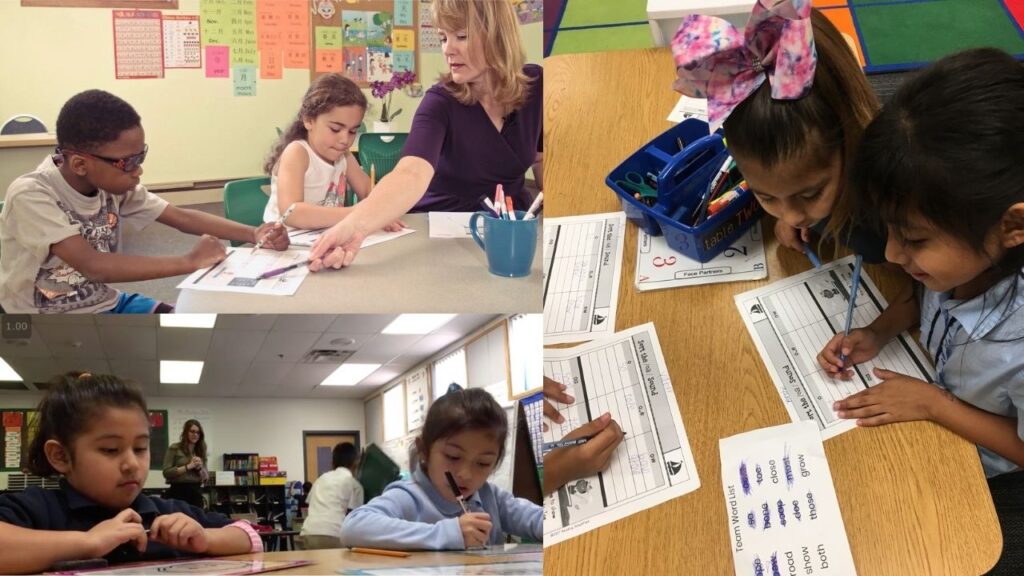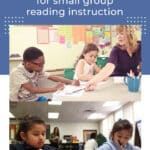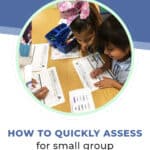
In this post, I want to talk about how you can take a handful of reading assessments and then group your students using those assessments quickly and easily. This will mean that you can get started with guided reading groups or small group reading instruction as fast as possible.
I hope that this will save you some time in planning and in classroom time so that you will see your readers accelerate, because that’s what we do here at Reading Simplified. So, let’s dive into this topic about quick assessments to help you group students with ease!
How Quick Assessment Tests Can Make Your Reading Groups
[01:28] – Quick assessments to help you group your students with ease
[05:26] – Tests that can help make your groups
[10:11] – How to use data to place students with 2 core activities – Switch It and Read It
[22:50] – How to place 1st grade and above readers into the right groups
(To watch the video where I discuss how you can quickly assess for small group reading instruction for kindergarten and first-grade level readers, hit play below or read on for a detailed overview)
3 Core Activities – The Backbone of Our Reading Assessments
When we use the Reading Simplified approach, we choose to use just three core activities called Switch It, Read It and Sort It.
You’ve probably heard me talk about these activities before if you’re a regular here. But if you’re new, you can learn all about these three core activities here: readingsimplified.com/start-here
The grouping assessments I’m going to recommend to you are based on these three core activities. So, it’s worth taking some time to familiarize yourself with them before trying these quick and easy reading assessments with your students.
Knowing how these three core activities work will help you to group your students better while streamlining your reading instruction and saving you a lot of precious time!
Now, let’s get into how you can start grouping your students…
Quick Assessments to Help You Group Your Students with Ease.
The first thing I want to do is break up the types of groupings into 2 categories:
- Kindergarten and 1st-grade level readers
- Mid 1st-grade and above

First, I’m going to talk about readers who are at the kindergarten or early 1st-grade level. The 2 tests that can help make grouping students simple are:
1. Phoneme segmentation
2. Nonsense word reading – informal
If you're working with kids who are 1st-grade readers and up, you need to think more about these tests:
1. Nonsense word reading – standardized
2. San Diego Quick Assessment (Word ID)
3. Reading Rate (fluency) that relates to Word ID above
Those are the two types of communities that we're thinking of and the types of tests for each of them. So, if we we’re thinking about those early first graders or kindergarten level readers, kids who are reading at that level, this is what I'd recommend….
Quick assessments for K – early 1st-grade readers
If you’re teaching students within this reading level, this is what I recommend:

A phoneme segmentation assessment is a test where you call out a word orally and ask the students to tell you the sounds that they hear.
For example, you might call out the word “sit” and see if the student can segment or separate the sounds they heard in the word ‘sit.’ If they group two sounds into one, point that out once and let the student correct the answer.
To begin, start with the three sound level and gradually increase the difficulty as you go. So, you start at the CVC or three sound level, and then you get harder, like a four sound word or a CVCC word like “fast.” Can they hear the sounds /f/ /a/ /s/ /t/? Can they segment each of those?
You need to be one-to-one with the student to carry out a phoneme segmentation test. It won’t take very long. In fact, I don’t recommend you continue with this type of test if the student can’t segment any sounds in a given level.
This phoneme segmentation test is also a great way to test your student's letter-sound knowledge, so pay close attention!
Give a Nonsense Word Reading Test
When students tackle nonsense words, they have to rely on their sound-based decoding skills and knowledge of the alphabetic principle to decode the word.
Kids of all ages have a knack for tricking us with their reading ability. Yes, they might be able to recognize lots of high-frequency sight words, but they may not have the underlying strong sound-based decoding skills they need to progress and read fluently.

A nonsense word reading test gets around this problem because if a child tries to read a word he has never seen before, he can’t rely on his visual memory. Instead, the student must tap into his ability to decode phonologically.
When you’re giving a student a nonsense word reading test, you’ll show him a list of words while making sure to cover up lower rows. Keep score as you go, and when a student can’t read any ‘words’ in a given level, that’s when you stop.
If you would like to grab a free list of nonsense words for this type of reading test, go to readingsimplified.com/reading-test to access the free download.
How to use Data to Place Students with 2 Core Activities
After completing the tests, take the data to place the students with two core activities that are relevant for kindergarten readers or early 1st-grade reading level students.
Using data from the tests, Phonemic Segmentation and Nonsense Word Reading, we then place students based on that information and we place them into two activities.
These two activities will form most of our groups for kids who are reading at the kindergarten or early 1st-grade level.
TOP TIP: To accelerate readers faster, move them up at least one level above their assessment data. For example, if a student functions at the CVC level, move them to the CVCC level when it comes to doing the phonemic segmentation test.

It’s a good idea to do this because there’s no point working on something that the student is already a pro at. You want to keep challenging your students so that they can continue to develop and progress!
Grouping for Switch It
To quickly group students for small group reading instruction using the Build It and Switch It activities, let’s refer back to the results you got from the phonemic segmentation test.
To find out where your students should begin, take a look at the section on the left (see image below) to help decide which level on the right to place them.

Once you’ve placed your students, you’ll be able to put them into small reading groups where all of the children in the same group are at the same reading level. For example, if a group of students recognize over five letter-sounds but can’t segment CVC, they should start with the Build It activity (see above).
Build It requires students to build one word on the board at a time. The student would build the word, “mat,” and they just have an “m” and “a” and “t” in a scramble order to choose from. That's easier than Switch It, where they have to change “mat,” to “Pat” and “Pat” to “pot” and so on. If a student knows more than five letters sounds, which is great, but they can't segment CVC, that’s another reason to do Build It.
Keep in mind that if a student can segment CVC words, you can move them up to the next level. If they can segment CVC, you can move them to CVCC words like “help” or “fast.” However, you might have more advanced students who can segment five or six sound words such as CCVCC or CCCVCC, which means you can move them to Switch It and incorporate more nonsense words to challenge phonemic manipulation.
Grouping for Read It
Next, take the data from the nonsense word reading test and use it to place and group students for the Read It activity, which is another very important core activity for beginning, kindergarten and early 1st-grade level readers. This process works in the same way as grouping for Switch It.
Find where your student should be placed on the left column and follow the instructions on the right to identify what Read It word lists you need to use for each student.

If kids can recognize zero to five letter-sounds, it can pretty hard for them to read a new word if they can't recognize any letter sounds whatsoever. In this case, you want to wait a week and continue to focus on Build It. If some students can recognize 5+ letter sounds, they can start Read It.
For kids who can read nonsense words at the CVC or three sound level, you would start them with Read It at the four sound word level. Remember the principle that you move students up to a reading level that's higher than their current level of independence.
When kids can read CCVCC, it’s time to move onto Sort It, which adds the layer of teaching the advanced phonics, which covers the long vowels and all those other crazy vowel combinations that as reliable as the short vowels are.
Place each group along the Reading Simplified Streamlined Pathway
You can also place each group along the Reading Simplified Streamlined Pathway. The Streamlined Pathway is a one-page view of how any reader becomes fluent moving from not knowing many letters sounds to knowing advanced phonics, like long vowels and becoming fluent. It's a 12-step process (see below).

Basically, you take the Letter Sound Knowledge, the Phonemic Awareness, Phonemic Segmentation, and the Nonsense word, reading to place kids into two main activities, (mostly Switch It or Read It).
Then you group those children who are similarly able into clusters, and then you put those clusters at each level on the Streamlined Pathway.
Quick assessments for Mid 1st grade and above readers
Now, let’s take a look at the tests you can use to group Mid 1st grade and above readers. For most mid 1st-grade readers and above, turn to these 3 tests:
1. Nonsense word reading – standardized
2. San Diego Quick Assessment (Word ID)
3. Reading Rate that relates to Word ID above
Here's an example of a Nonsense word and a word identification test:


Based on their word identification, you choose a graded passage to give the students to read aloud and you time them. This is to help you see how many words they read correctly in one minute, and then you can compare that to national norms.
If you want to access these tests for free, go too: ReadingSimplified.com/reading-tests
Grouping advanced readers is very similar to how you group less advanced readers. You can then take that Nonsense word reading test data, which again is helpful because it focuses on whether or not they're using a sound-symbol matching approach, or sound-based decoding approach. Or, if they're just memorizing based on the beginning letter sound, or maybe parts of the letter-sounds in the word, but not really a full left to right blending of the word properties. That’s why the nonsense word test is so important!

You then group the kids for Switch It and Sort It in the same way as you would group less advanced readers. When you’re grouping for Sort It, you need to consider if students can read CVC nonsense words for the most part. If they can, you can begin Sort It with them. Students who read at higher grade levels can use harder word lists.

You can then use the data from the tests to place students into groups using the Reading Simplified Streamlined Pathway. The 1st-grade Streamlined Pathway is similar to the kindergarten version. You then pick a Switch It level that's applicable for those students, but you move quickly, if not immediately at the beginning of the year into advanced phonics and start with Sort It. So, some kids will be doing Switch It with five sound words and Sort It with fairly easy words, like “go” and “show,” while other kids will be doing Switch It with maybe three or four sound words.
One group may move within two or three days to level three, if they're just flying through this, but another group may take a whole week to do the /oa/ sound. You then must start to stagger your groups as they're shifting on their progression of the Streamlined Pathway.
If you would like to get your hands on the FREE reading assessment tests for small group reading instruction that I talk about in this post and video, just leave your name and email address below and your free downloadable PDF of the Snapshot Informal Reading Assessment will be delivered straight to your inbox!
Have you tried using any of these reading tests to assess your students for small group reading instruction? Let me know how you got on in the comments and if you have any questions, post them below!




May I have a free PDF of the snapshot informal reading assessment?
Hi Caroline! Keep an eye on your email for that!
Thanks, this is very helpful.
Great!! Good to hear Pamela.
Thanks for this helpful information. I think I’m still missing how these assessments relate to the streamlined pathway. For example, I teach 5th graders who are pretty “behind.” If I use your informal snapshot assessment for nonsense word reading, and a student can read CVCC mostly, then I use Switch It with CCVCC, right? But I don’t see how that corresponds to the streamlined pathway. Is the student on that first level (short vowels, consonants, etc.) until they test ready for “Advanced Code?” Where should students “score” on an assessment before we continue on with the sequence and go to /oa/, /ee/, etc.? Thanks.
Andrew, yes, about the Switch It question. We have an in-depth Interpreting the Snapshot Informal Assessment in the Intro unit of the Main Course in the Reading Simplified Academy. I also teach about the Pathway in that same unit.
We begin everyone on the first level of the relevant Pathway. We have 3 inside our Reading Simplified Academy; they refer to a student’s reading level (K, 1st, or 2nd+). The first step in all of them is at least a review of short vowels (which we teach, in part, via Switch It). Once a student can blend CVC words about 70% of the time, we move up the step to Advanced Phonics (i.e., the /oa/ sound). So for most intervention students, that first step on the Pathway and the next step (i.e., /oa/ sound) can happen in the first lesson or first week.
You can see an example of a 6th grader reading at the 4th grade level here:
After the beginning phase, Switch It leads a life of its own and doesn’t tie to the Pathway anymore. We explain this in the Intro to the Reading Simplified Framework in Unit 1 of the Main Course of the Reading Simplified Academy and in the advanced workshop called a Switch It Primer.